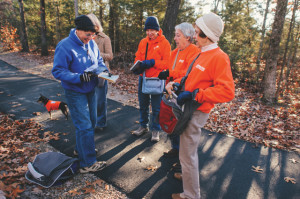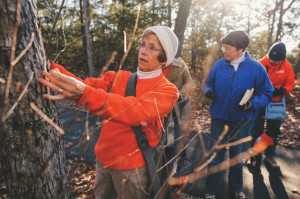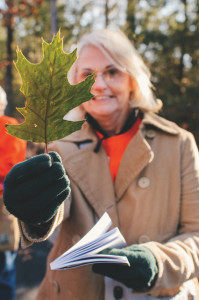
“If you don’t know what you have, how can you properly steward it?” wondered Julie Lovett, Bull Shoals-White River State Park interpreter. “What if they happen to construct a new building where the last ash tree in the park is living?”
So in June 2011, she initiated the Bio-Inventory project currently underway at the park, a collective effort by the park and the North Central Arkansas Master Naturalists. The group has the monumental task of inventorying every single living thing within the 732.25-acre boundaries of Bull Shoals-White River State Park. The findings will be used in interpretive programs and state park planning, and will eventually be listed in an online catalogue available to the public, complete with GPS coordinates for each entry.
The inventory also provides a record that demonstrates the sustainability of a species within the park. If multiple deer, wood frogs, or wolf spiders, or even Copperhead snakes are spotted in an area and have virtually disappeared a couple of years later, the change can alert park employees to a critical disturbance in the ecosystem.

“Somebody was looking for pawpaws here last summer,” says Dwan Garrison, past NCAMN president. When the inventory is made available online, people will be equipped with the exact global positioning coordinates to lead them in their searches. And in case you’re wondering, yes, the master naturalists did find some of the unique, fruit-bearing trees within the park.
Botanist Ellen Chagnon leads the team of about 45 members tackling the project.
“When Ellen joined [the NCAMN], and we knew we had a professional botanist, that sparked a light,” Garrison says. “Here is someone who could actually get us started on this!”
Working twice a month since 2011, the team has logged more than 2,000 data entries, including plants, birds, insects, reptiles, amphibians, mammals, fungi, fish, and macroinvertebrates, such as dragonflies. The entries serve as a tremendously significant record that park employees can reference if, for instance, they want to carve a new road in the least environmentally-invasive location possible.

“Knowing where you have populations of unusual or rare species will keep you from building a road through that area,” Chagnon says. “It’s about understanding the treasures you have within the park.”
Documenting every living thing in the park has opened the eyes of first-year Master Naturalist Linda Moore. “It was like a whole new world for me,” she says. “I’ve learned so much, and yet there’s so much more to learn.”
“There’s a lot of power in naming things,” agreed Chagnon.
You can experience that power by joining North Central Arkansas Master Naturalists. Learn more at home.arkansasmasternaturalists.org. Classes begin in January at BSWRSP.
M! FM 2013

Leave a Reply